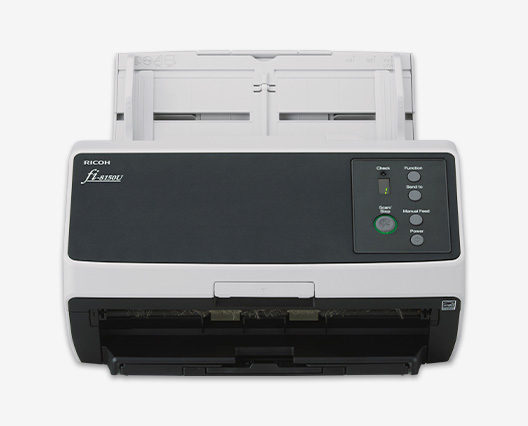
fi-8150
ADF Scanner for Light Workloads

Colleges and other educational institutions require an effective enterprise content management (ECM) system due to the large volumes of personal student files, contracts, invoices, forms, and a plethora of other documents. Palm Beach State College (PBSC) serves thousands of students across four campuses located within the Florida hurricane zone. Due to their location, disaster recovery played a big part—as did the need for space and improved efficiency—in their search for an enterprise content management (ECM) system.
Previously, PBSC had experienced two failed attempts at implementing an ECM system. They approached the project again, this time hiring a consultant and building a business plan. With multiple locations, up to an hour apart from one another, PBSC was often constrained by the limitations of paper files. The need for simultaneous access to information without faxes and phone calls was apparent.
To get the information into the system, PBSC would need scanners throughout its campuses.
“We looked at different scanning companies and measured their capabilities against a number of criteria that were essential to our business processes. Obviously, the quality of the scan was crucial. We also looked at the ability to handle odd- and mixed-size documents, auto feed, duplex scanning, color scanning, TWAIN imaging, and other factors.”
After careful evaluation of their options, PBSC found an integrated solution that met all of their requirements: the DocFinity software suite from Optical Image Technology paired with fi Series document scanners.
The ECM software offered the scalability for successful implementation both departmentally and enterprise-wide. A professional services team offered on-site support in order to ensure success and a back file conversion enabled everything to be in digital format when they went live.
The Registrar's office, Admissions, and Financial Aid were the first to adopt the technology. By simply handing their student ID to a staff member to be scanned, the student's information could be automatically imported on site from the DocFinity system. 65 fi Series document scanners were eventually placed on desktops, counters, mail stations, and throughout the Human Resources department across all four campuses.
Zettler explains, “Since we have to scan a photo id for every student and employee, we wanted a scanner that we could feed a driver's license and that would scan a color image. The scanners require minimal support, and we've been extremely pleased with their capabilities.”
Zettler says that the ECM system had been particularly valuable to the Financial Aid office. “One of the most labor-intensive and cumbersome processes for students is Verification, which is a federal requirement to collect several pieces of financial and personal information from students and/or parents.” Rather than waiting for all components of a package to be received – and relocated to one location – documents could now be scanned individually at any of the four campuses and routed electronically to the correct processor before final submittal.
“We're also able to image-enable HR documents using our network of fi Series document scanners,” said Zettler. “Paper documents are scanned and indexed at the point of receipt, and accessible immediately to authorized personnel from any web browser.”
PBSC used DocFinity to store current employment records, as well as all of their historical employment records. All employment applications, W-2 forms, and other HR documents were scanned into the system and stored.
“Our HR folders are larger and more complex than student records. Student files may contain eight to ten pages, but HR files may be comprised of fifty to sixty pages on average. Nonetheless, they can be imaged and stored in the same electronic repository that houses student records.”
PBSC also integrated DocFinity with their PeopleAdmin system where prospective employees viewed job openings and posted their résumés and other related documents. Once candidates were selected for employment, their information was automatically transferred to DocFinity to be stored. This was a vast improvement over the previous manual process of printing and filing each résumé.
After HR adopted the enterprise content management system, PBSC was able to share documents electronically across their multi-campus environment. This sped up the hiring process and enabled each department to have access to the information they needed.
PBSC imaged and stored millions of documents using this digital filing system. Their success with ECM serves as a valuable lesson to other organizations.
Zettler summarizes, “The distributed fi Series scanners of our DocFinity implementation has great relevance to other institutions. When information is scanned as soon as it is received, it is accessible immediately to authorized users throughout the entire enterprise.”